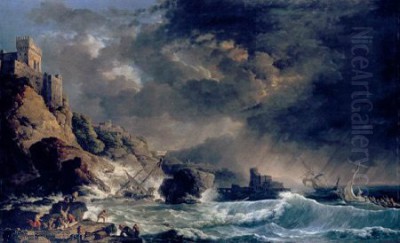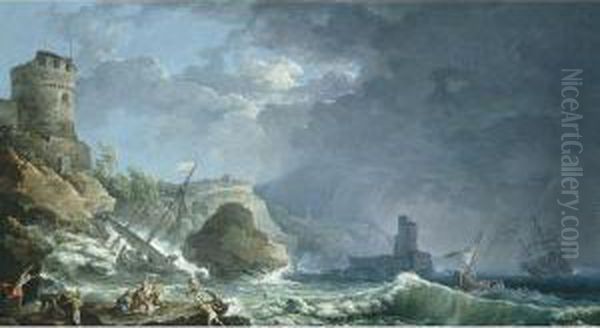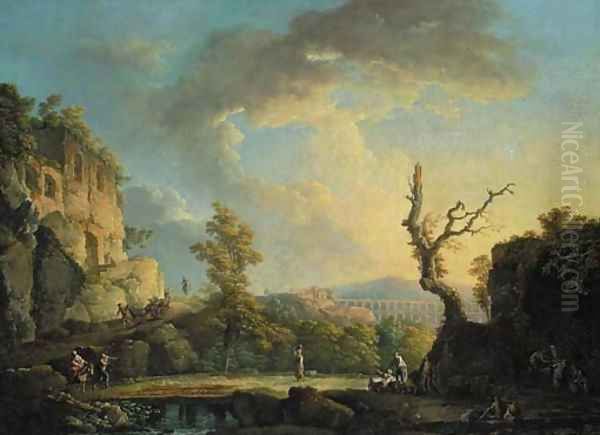
Carlo Bonavia, an enigmatic yet significant figure in eighteenth-century Italian art, carved a distinct niche for himself as a painter of luminous landscapes and evocative coastal scenes. Active primarily in Naples between roughly 1751 and 1788, Bonavia's work captured the unique atmosphere of Southern Italy, blending keen observation with a romantic sensibility that appealed greatly to both local patrons and the burgeoning market of Grand Tourists. His art stands as a testament to the enduring allure of the Italian landscape and the cross-currents of artistic influence that characterized the period.
Origins and Artistic Formation
While the precise details of Carlo Bonavia's birth and early training remain somewhat obscure, he is generally considered to be of Italian nationality, possibly with origins in Rome before establishing his career in Naples. The period of his most prolific activity is documented from 1751 until his death, which is believed to have occurred around or shortly after 1788. Naples, at this time, was a vibrant cultural hub, a key destination on the Grand Tour, and a city with a rich artistic heritage, providing a fertile ground for a landscape painter of Bonavia's talents.
Bonavia's artistic development was profoundly shaped by two major, yet distinct, artistic forces: the dramatic, often wild landscapes of Salvator Rosa (1615-1673), and the more refined, atmospherically nuanced marine and landscape paintings of the French artist Claude-Joseph Vernet (1714-1789). Rosa, a Neapolitan by birth, had established a powerful tradition of landscape painting characterized by rugged terrain, tempestuous skies, and a sense of the sublime. His influence can be seen in Bonavia's occasional depiction of stormy seas and dramatic natural formations.

However, it was Vernet who arguably exerted the more dominant influence on Bonavia's mature style. Vernet spent a significant period in Italy, including visits to Naples (notably around 1737 and 1746), and his work was immensely popular. He was celebrated for his ability to capture a wide range of atmospheric effects, from serene sunrises to violent storms, and for his skillful rendering of light on water and land. Bonavia appears to have absorbed Vernet's sophisticated handling of light, his delicate color palettes, and his compositional strategies, particularly in his coastal views and harbor scenes. Indeed, some of Bonavia's earlier works were so similar in style that they were occasionally confused with those of Vernet, a testament to Bonavia's skill in emulating the master.
Signature Style and Thematic Focus
Carlo Bonavia developed a distinctive style that, while indebted to his predecessors, possessed its own unique charm and appeal. He specialized in idyllic and picturesque views of the Neapolitan coast and its surrounding countryside. His canvases are often suffused with a soft, golden light, creating a dreamlike, almost ethereal atmosphere. This mastery of light and shadow (chiaroscuro) allowed him to imbue his scenes with a sense of depth and realism, while simultaneously evoking a romanticized vision of nature.
His subject matter frequently revolved around the Bay of Naples, the Phlegraean Fields (Campi Flegrei) with their ancient ruins, and pastoral inland scenes. These locations were not only scenically beautiful but also rich in historical and mythological associations, which resonated deeply with the classically educated Grand Tourists. Bonavia often included small figures in his landscapes – fishermen, peasants, or elegantly dressed ladies and gentlemen – which served to animate the scenes and provide a sense of scale, a technique also masterfully employed by artists like Claude Lorrain (1600-1682) in an earlier generation.
Bonavia's paintings often exhibit characteristics of the Rococo style, with their graceful compositions, delicate brushwork, and emphasis on charm and elegance. However, there is also a burgeoning Romantic sensibility in his work, particularly in his depiction of nature's grandeur, the evocative power of ancient ruins, and the occasional portrayal of dramatic weather conditions. He was less interested in the topographical accuracy of a veduta painter like Canaletto (1697-1768) or Francesco Guardi (1712-1793) in Venice, or even Gaspar van Wittel (Vanvitelli, 1653-1736) who worked extensively in Rome and Naples. Instead, Bonavia often created capricci – architectural fantasies or idealized landscapes that combined real elements with imagined ones to create a pleasing and evocative composition, a genre also explored by Roman artists like Giovanni Paolo Panini (1691-1765).
Masterpieces and Representative Works
Several paintings stand out in Carlo Bonavia's oeuvre, showcasing his characteristic style and thematic preoccupations. Among his most celebrated are a pair of views depicting the ancient Roman resort of Baiae, both dated to around 1760.

View of Baiae with the Temple of Diana captures the serene beauty of the coastline, with the prominent, though misidentified, ruins of the so-called Temple of Diana. The scene is bathed in a warm, gentle light, and the calm waters reflect the sky and surrounding landscape. Small figures populate the shore, adding a touch of everyday life to the historical setting. This work exemplifies Bonavia's skill in blending natural beauty with classical antiquity, creating a picturesque and historically resonant image.
Its companion piece, View of Baiae with the Aragonese Castle and the Temple of Venus, offers another perspective on this historically rich area. The imposing Aragonese Castle dominates one side of the composition, while the ruins identified as the Temple of Venus are visible nearby. Again, Bonavia's masterful use of light and atmosphere creates a harmonious and inviting scene, appealing to the viewer's appreciation for both natural scenery and ancient history. These Baiae views were highly sought after, reflecting the contemporary fascination with the archaeological discoveries and classical sites around Naples.
Another significant work is A Storm off a Rocky Coast, painted in 1757. This piece demonstrates Bonavia's ability to depict the more dramatic aspects of nature, clearly showing the influence of Salvator Rosa and Vernet's storm scenes. The crashing waves, dark clouds, and ships struggling against the elements create a sense of dynamism and power. Yet, even in such a dramatic scene, Bonavia maintains a certain elegance in his composition and a nuanced handling of color and light, particularly where it breaks through the clouds. This painting is often cited as one of his most accomplished and emotionally charged works.
Other notable paintings include Landscape with a Water Channel, which showcases his ability to render tranquil rural scenes near Naples, and Castle and Waterfall, another example of his picturesque compositions that often blended real and imagined architectural elements with natural features. He also painted views of the famous Castel dell'Oro, a prominent Neapolitan landmark, and scenes like the Teverone Cascade, demonstrating his interest in varied landscape motifs.
A particularly interesting aspect of Bonavia's work is his depiction of Mount Vesuvius, especially during its eruptions. These paintings, such as an untitled Eruption of Vesuvius, were not merely picturesque views but also captured a dramatic natural phenomenon that fascinated and terrified contemporaries. Artists like Pietro Fabris (active 1740-1792) and later Pierre-Jacques Volaire (1729-c.1799) also specialized in Vesuvius eruption scenes, catering to the immense demand from visitors. Bonavia's contributions to this genre highlight his direct engagement with the dynamic and sometimes perilous environment of Naples.
Bonavia in the Neapolitan Art Scene and the Grand Tour
Carlo Bonavia operated within a thriving Neapolitan art world. While major figure painters like Francesco Solimena (1657-1747) and later Corrado Giaquinto (1703-1766) dominated large-scale commissions, there was a strong and distinct tradition of landscape painting. Artists like Leonardo Coccorante (1680-1750) had earlier specialized in dramatic architectural capricci and coastal scenes, setting a precedent for painters like Bonavia. Contemporaries in Naples included landscape and veduta painters such as Gabriele Ricciardelli (active c. 1740-1780) and Antonio Joli (c. 1700-1777), who also captured the city and its environs, though often with a more topographical focus.
Bonavia's success was significantly tied to the Grand Tour. Eighteenth-century Naples was an essential stop for wealthy young aristocrats and intellectuals, primarily from Britain and Northern Europe, who traveled to Italy to complete their classical education and experience its cultural riches. These travelers were eager to acquire mementos of their journey, and paintings of famous sites and picturesque landscapes were highly prized. Bonavia's works, with their manageable size, appealing subject matter, and evocative atmosphere, were perfectly suited to this market. His paintings offered an idealized yet recognizable vision of the Italian south, capturing the blend of natural beauty, classical heritage, and local color that so captivated visitors. This demand also supported portraitists like Pompeo Batoni (1708-1787) in Rome, who painted Grand Tourists amidst classical ruins.
The influence of Claude-Joseph Vernet was pervasive, not only on Bonavia but also on other artists. Francesco Fidanza (1747-1819), for instance, was another painter who followed in Vernet's stylistic footsteps, and his work sometimes shows an affinity with Bonavia's own interpretations of the Vernet-esque landscape. While direct records of Bonavia's personal interactions with many of these artists are scarce, his work clearly participated in a shared visual language and catered to a similar clientele. His paintings were exhibited in various European art galleries, indicating a reputation that extended beyond Naples.
Beyond easel paintings, Bonavia also occasionally engaged in other artistic activities. There is evidence, for example, that he provided designs for a public fountain in the Lagagnasco area, suggesting a versatility that extended to decorative or public works. This involvement, though perhaps minor in the grand scheme of his career, indicates his recognized status as an artist within the Neapolitan community.
Later Career and Lasting Legacy
Carlo Bonavia continued to paint actively through the 1770s and 1780s. While his style remained largely consistent, his later works sometimes show an even greater refinement in the handling of light and a subtle evolution in his compositions. He maintained his focus on the landscapes and coastal views that had brought him success, adapting his themes to the enduring tastes of his patrons.
The exact date of his death is not definitively known but is generally placed around 1788 or shortly thereafter. After his passing, the tradition of Neapolitan landscape painting continued with artists like Jacob Philipp Hackert (1737-1807), who brought a more Neoclassical clarity and topographical precision to the genre, yet the romantic and picturesque qualities championed by Bonavia and his generation left a lasting mark.
Today, Carlo Bonavia's paintings are held in numerous public and private collections worldwide, including the Museo di Capodimonte in Naples, the Honolulu Museum of Art, the St. Louis Art Museum, and the Fitzwilliam Museum in Cambridge. His works are appreciated for their aesthetic charm, their skillful execution, and their value as historical documents of eighteenth-century taste and the allure of the Italian landscape.
He is recognized as an important figure within the Neapolitan school of painting, particularly for his role in popularizing a more lyrical and atmospheric approach to landscape, effectively bridging the gap between the dramatic Baroque tradition of Rosa and the emerging sensibilities of Romanticism. His ability to synthesize influences, particularly that of Vernet, into a personal and appealing style ensured his contemporary success and his enduring place in the history of art.
Conclusion: An Artist of Atmosphere and Allure
Carlo Bonavia remains a captivating, if somewhat under-documented, figure from a golden age of Italian landscape painting. His art transports the viewer to the sun-drenched coasts and idyllic countryside of eighteenth-century Naples, offering a vision of Italy that is both timeless and deeply rooted in the cultural preoccupations of his era. Through his masterful control of light, his delicate rendering of atmosphere, and his picturesque compositions, Bonavia created a body of work that continues to enchant. He skillfully navigated the artistic currents of his time, drawing from the legacy of Salvator Rosa and the immense popularity of Claude-Joseph Vernet to forge a style that was distinctly his own. As a chronicler of Neapolitan beauty and a favored artist of the Grand Tourists, Carlo Bonavia left an indelible mark on the landscape tradition, and his paintings remain cherished examples of Rococo charm and early Romantic sensibility.